A purely regulatory approach to cutting carbon is like Thanksgiving dinner without the turkey. But just charging polluters without any other policies is like eating turkey by itself with no cranberry sauce or stuffing to make it delicious, no mashed potatoes, green beans and yams to round out the meal, and no pie to sweeten the experience. In Oregon and Washington, we want the full dinner. Here’s how serving up a carbon price carefully paired with other policies makes for a delicious meal.
Policies can complement making polluters pay in the following ways:
- Keep costs down by slashing carbon that a price can’t reach because of market barriers
- Achieve other benefits—cleaning the air, developing new clean tech industries—in addition to trimming carbon pollution
- By doing both of the above, complementary policies can pick the low-hanging fruit as well as the exotic fruit and put them all together in one reasonably priced basket.
How to read a marginal abatement cost curve.
To explain how this works, I need to show you some marginal abatement cost curves. That name sounds intimidating—like something you’d need an advanced degree to understand. But they’re actually simple and incredibly informative. Think of them as the stair steps of opportunity.
The cost curve immediately below is for Australia. I’m using it because it is especially easy to read and understand. A marginal abatement cost curve takes many possible discreet steps to pare pollution (aka, “abatement”) and lines them up from left to right according to their cost. Cheap options for reducing or capturing carbon are on the left; expensive ones are on the right. The vertical axis shows the cost of cutting carbon pollution in dollars per ton. The horizontal axis shows the total million metric tons (MMT) any given policy could cut. The idea is to climb the stairs from left to right, starting with the cheapest options and working your way up to the more-expensive ones.
On the left side of the graph you see negative bars, meaning Aussies could save money by enacting these policies. The further right you go, the more expensive it gets to trim emissions. The wider the bar, the more MMT it could cut. The color-coding in this example shows you that most of the money-saving options are in making buildings (light blue) and transportation (dark blue) more efficient, that there are many low-cost options for reducing emissions or soaking up carbon by protecting or replanting forests (green), and that higher-cost options are in the power sector (gray).
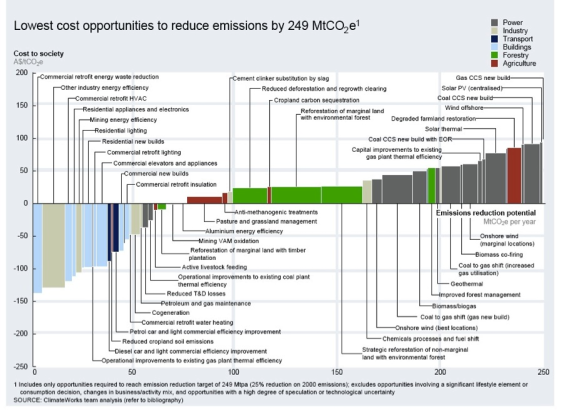
Below is a US curve from the consulting firm McKinsey & Company.
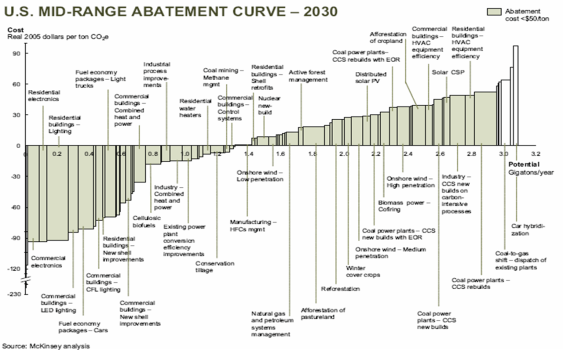
The negative bars on the left side—the things that actually save money while cutting pollution—are mostly ways to make appliances, buildings, and vehicles more efficient. For example, by putting all our gadgets and lights on an energy diet we can chop down pollution while also saving cold hard cash. Above, you will see the bar labeled “Residential buildings – lighting” could reduce pollution by about 100 million metric tons (MMT) (the axis shows gigatons) and save $95 per ton. “New shell improvements” means insulating new buildings better so they use less energy for heating and cooling. “Fuel economy packages” for cars and trucks means getting more miles for your dollars. Above, the bar labeled “Fuel economy packages – cars” show that the United States could cut about 50 MMT of pollution and make $80 per ton. These policies are like salad: the guilt-free option you should try to fill up on first.
On the right side are the more expensive actions. The very last blue bar, “Coal power plants – CCS rebuilds” means that retrofitting existing coal plants with carbon capture and storage technology could cut about 120 MMT of pollution at a cost of about $55 per ton. Adding CCS to coal plants might be like the unappetizing holiday fruitcake that you never get around to eating. “Distributed solar PV” and “Solar” are also on the right half of the graph, but the prices of these options has fallen steeply since McKinsey completed this analysis in 2007.
Why, why, WHY are we not already doing things that could save money AND cut pollution?
The negative bars are all money-savers even without making prices tell the truth about carbon pollution. The fact that we have not done these things yet shows that something other than cost is blocking us. There is a market failure or other barrier. Examples include:
- Imperfect information: it is easy to compare the sticker prices of two refrigerators but hard to compare their lifetime costs—purchase price plus electricity bills to keep the fridge humming day after day for 10 years or more.
- The “split-incentive” or “principal-agent” problem: the person paying the electricity bill has a big incentive for the building to be as efficient as possible, but the architects, builders and landlords who design, build, and maintain the building may not care so much. They aren’t paying the bill.
- Another example of split incentives: TV set-top boxes (the box that funnels cable or Netflix into your TV) use almost as much energy when they are off as when they are on. Manufacturers ship them with the default setting to stay at full power because. . . what do they care about your electricity bill? Customers could re-set them to power down when idle, but it’s hard enough to program the internal clock much less figure out the energy-saving options.
- Upfront cost vs operating costs: Tax policy favors higher operating costs. Operating costs can be written off, but capital costs are taxed for 30 years. This dichotomy encourages inefficient buildings that cost less to construct and more to operate. Similarly, an efficient car might save thousands of dollars over the years, but a cash-starved purchaser may not be able to swing a higher purchase price today.
Examples of other barriers to cost-saving solutions include;
- It is cheaper and more efficient for people to live close to each other and close to amenities like grocery stores and doctor’s offices, but land use planning has historically oversupplied suburban housing and undersupplied urban housing.
- Charging for car insurance based on how much you actually drive saves money, but state laws may prevent insurers from offering it, and people might not sign up because they don’t understand the benefits.
- Although energy efficiency savings add up to billions of dollars across Cascadia, the amount of money that individuals can save is typically one percent or less of their disposable income. Not very motivating.
Charging carbon polluters will make money-making carbon-cutting tactics save even more money, but the price won’t overcome whatever barriers are already blocking them.
In 2012, the Oregon Department of Energy did a marginal abatement cost analysis. In the graphs below, I look at three scenarios: (1) skipping the complementary policies (turkey by itself), (2) using only the policies that get negative-cost policies (healthy salad), and (3) a carbon price plus a mix of high-cost and low-cost options (full dinner).
Scenario 1: Charge carbon polluters, use no complementary policies.
A carbon charge of $50 per ton will curtail the pollution that costs between $0 and $50 per ton. For example, preserving a forest that sequesters carbon might cost $12 per ton, so in the absence of a charge on spewing pollution into the air, those forests will get cut. But if polluters pay $50 per ton, preserving that forest transforms from a $12 per ton cost to a $38 per ton profit. For the sampling of Oregon policies that I am using for illustrative purposes, a carbon price of $50 per ton (the orange line in the graph below) would cut 8 MMTs of pollution (the darker green boxes) at an average cost of $40 per ton. This is a turkey dinner with just turkey. Not very satisfying.
(Reminder: the cost curve below only includes a sampling of all the policies Oregon could pursue, so the MMT and $ per ton numbers are only helpful in comparing one scenario to another within the bounds of this article, not for making any conclusions about the tons and costs in Oregon more generally.)
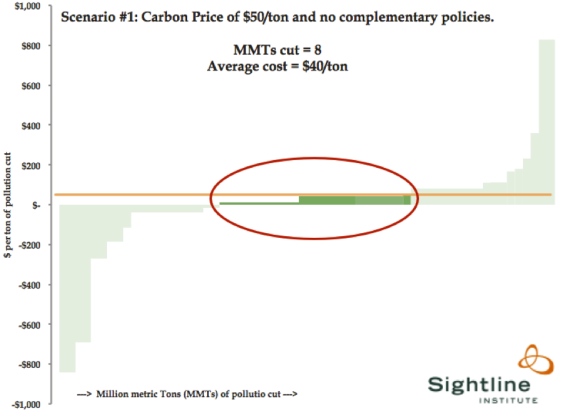
Scenario 2: Get all the low-cost stuff.
What if we go after all and only the cheap stuff? If we could formulate policies designed to overcome all the market barriers, we could cut 8 MMTs of pollution at an average savings of $219 per ton (darker green bars in the graph below).
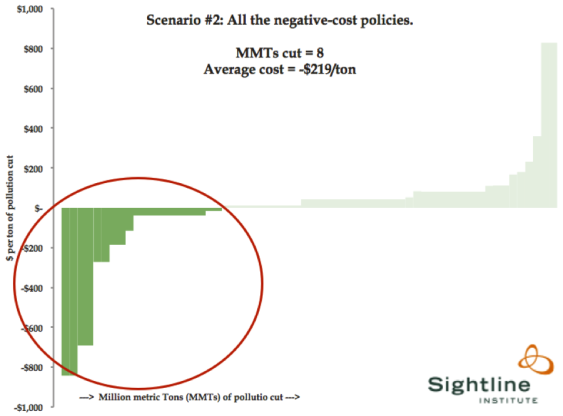
Scenario 3: A combination platter.
Say we go after a lot of the low-cost options, but we don’t have the right policy tools to overcome all the market barriers. We use a price to capture all the lower-cost options. And we also have reasons for wanting some higher-cost things—say, rooftop solar—because it has advantages other than just cutting carbon—like promoting energy independence and driving new technologies to competitiveness by helping them get up to scale. A combination of a $50 per ton charge on polluters plus policies aiming at most of the cost-saving energy efficiency plus high and low cost policies could cut 15 MMTs of pollution at an average savings of $34 per ton.
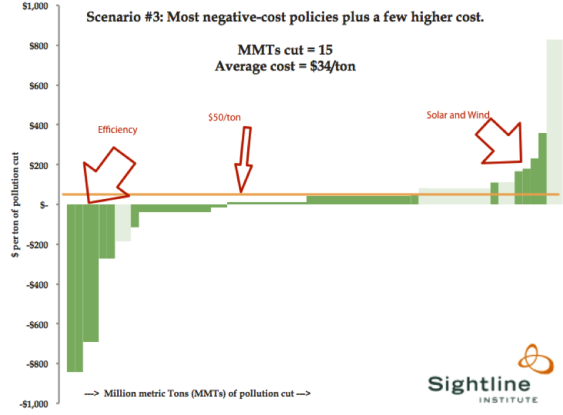
Complementary policies keep costs down.
A price without other policies would miss a huge swath of cost-saving carbon-cutting options. We would have to fill up on turkey alone, which would be both more costly and less tasty than the alternative.
Why charge for carbon pollution at all?
If sides are so cheap, maybe we should ditch the turkey and go vegetarian! Maybe we should forget the carbon price and just implement policies designed to achieve all the negative cost options. Not so fast. There are several reasons that approach might not work out as well as hoped:
- Economists don’t know everything. All due respect to economists. The marginal abatement cost curves are estimates. The Stanford economists who analyzed a cost curve for California’s AB 32 made clear that many of the cost estimates are very uncertain. Using an economist’s estimates as gospel that guides all policies could lead a state astray.
- Agencies can’t do everything. As I have detailed, even if we were sure that the estimated cost curves are right and we wanted to set agencies to the task of overcoming all the market barriers to the low-cost options, agencies might not have the necessary authority and jurisdiction to accomplish the task. A carbon price is in the background of any combination of policies, constantly nudging the economy towards clean choices.
- We can’t predict the future. Even if economists were omniscient and even if the agencies were omnipotent, things can change. What if the state writes all the regulations and puts all the enforcement mechanisms in place to encourage a certain type of traffic and parking management that should cut emissions at a negative cost. But then, 20 years from now, most people are hiring self-driving-car service to get around, rather than driving themselves in their own car. The state’s traffic and parking management policies were carefully designed around the assumption that most people are driving and parking their own car, so those policies are now irrelevant.
- We want innovative future solutions. A marginal abatement cost curve measures the solutions we know about and can measure now. Prescriptive policies aim for a specific outcome in a certain world, but making polluters pay for their pollution sends the signal that we need to invest in clean solutions and encourages innovative solutions. A carbon price sends the market signal that we are moving from dirty energy to clean, and innovators will respond with new ways to bring about a clean energy economy.
Better together.
We urgently need to hold polluters accountable so that we can move into a clean energy future. Targeted policies can cost-effectively diminish pollution and achieve other benefits such as energy independence and improved public health. But we also need to navigate a longer-term shift in our economy in an uncertain world. A carbon price can guide that shift. In the end, the best dinner serves up turkey, sides, and dessert.


Comments are closed.